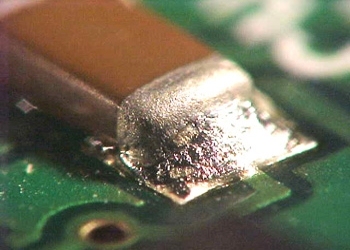Posted By: ITA-Admin | Date: November 27th, 2014

How do you ensure you make the right choice of alternative solder alloy?
If you have a good process with good yields and a reliable product, why would you need to change?
If you’re exempt from RoHS, you might not need to change.
However, maybe by changing you will:
 It pays to get advice when choosing a new solder, but you know your product best. Talk to solder suppliers, subcontractors and conduct Benchmarking.
It pays to get advice when choosing a new solder, but you know your product best. Talk to solder suppliers, subcontractors and conduct Benchmarking.
You need to ensure suitability through representative testing. Thermal cycling is generally carried out, but it must represent the environment that your product is used in, but accelerated. This can be achieved by adding a little to each temperature extreme, for example. To make it meaningful though, it needs to be compared against something, for example the alloy presently in use or an alternative alloy.
After cycling, the product will need to be examined for evidence of damage to the joints using Optical microscopy & Cross-sectional analysis. You might carry out Mechanical Testing, or Dye & Pry as well.
You will also need to think about the solderability and whether it will work with your present flux/components. A new alloy may require a different flux which could require Contamination Testing.
Starting Point: SnPb
It’s been used for thousands of years & is what the industry is “used to.” It generally has good wettability, strength and reliability, but there is increasing legislation against it.
There are alternatives such as SAC 305 / SAC 405, which is still the ‘drop-in’ replacement for SnPb. It also has good wettability, strength and reliability. It has a slightly higher melting point, but there are concerns over its drop shock and copper erosion performance. There is also the fluctuation in the cost of silver.
The Second generation lead free alloys are lower in silver, which is good for drop shock resistance, lower cost and reduced copper erosion. However, they can have reduced wetting and strength and don’t have a single melting point.
There are also ‘no silver’ alloys, which are also good for drop shock resistance, lower cost, reduced copper erosion, but are eutectic. However, they have reduced wetting and strength, and often require higher processing temperatures.
Then there are newer alloys for High Reliability (I.e. Innolot), Low melting temperatures (e.g. SnBi & SnZn), which is before we discuss composite Solders, Conductive Adhesives and solderless technologies.
It pays to get advice when choosing a new solder, but you know your product best. Talk to solder suppliers, subcontractors and conduct Benchmarking.
You need to ensure suitability through representative testing. Thermal cycling is generally carried out, but it must represent the environment that your product is used in, but accelerated. This can be achieved by adding a little to each temperature extreme, for example. To make it meaningful though, it needs to be compared against something, for example the alloy presently in use or an alternative alloy.
After cycling, the product will need to be examined for evidence of damage to the joints using Optical microscopy & Cross-sectional analysis. You might carry out Mechanical Testing, Shear Testing or Dye & Pry as well.
You will also need to think about the solderability and whether it will work with your present flux/components. A new alloy may require a different flux which could require Contamination Testing.
To discuss ways in which ITA Labs can help you choose an alternative solder please call Wayne Lam on 01727 871328.
For information on the full range of electronics testing services available from ITA Labs request a brochure here.